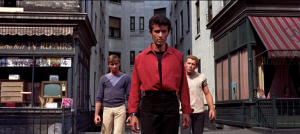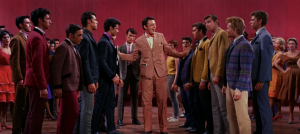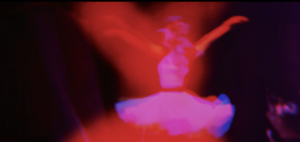5 West Side Story (1961)
Difference, Power, and Discrimination in West Side Story
By Jolene Vallejo
West Side Story is a modern reinvented Romeo and Juliet story told through the streets of New York in 1961 as a musical. In this (at the time) modern-day star-crossed lovers story, two young teens from rival gangs fall in love while the two groups fight over turf. In this tale, we see the rivalry between two different races, Americans and Puerto Ricans. This is what fascinated me about the film, not only it being a musical with outstanding performances, but the inclusion of another race playing main roles within the film. Although this film does show the equal inclusion of Puerto Ricans and Americans, there is an inaccurate representation and clear stereotyping that occurs through the use of visual effects, cinematography, and sound and details in clothing or surroundings that discriminates against Latinos.

First, the film uses stereotypes to depict Puerto Ricans as foreign others and shows off the issues of migration and discrimination at the time. During the release of the film, there was a major migration of Puerto Ricans coming to America and this film helped present that but in a way that it also inaccurately represented them. The issues in the film were extremely relevant to what was happening at the time and Hollywood played a big role in how characters were seen on screen in West Side Story. Because Latin people were from other countries, they were often seen as dangerous and different from Americans. Therefore, many if not all, Latin characters were portrayed as violent and tough characters or hopelessly in love. In addition, they were also treated as poorly and made fun of such as the medium-long shot above of the Jets making whistling sounds at one of the Sharks like he was a pet or a dog for example. Puerto Rican writer, Carmen del Valle Schorske, has also recognized these issues as she states “My mother taught me to resist the cartoonish stereotypes of macho teenage gangsters and hysterical lovers in “West Side Story” in The New York Times (Schorske). The migration of Puerto Ricans may have influenced the film’s upbringing but the representation isn’t much of an accurate one and has only brought issues of discrimination, difference, and power upon the Puerto Rican community.
Difference is encoded in the film using mise-en-scene to differentiate the Jets and the Sharks who are different races, but also, the roles of the characters play distinguishes difference. It’s always very important to pay attention to details in film and in West Side Story details are used to show the difference between the rival gangs. Starting with looking into the meaning behind the names of each gang as they hold underlying connotations. The Jets for example, can be associated with flying objects and “something that makes advancements in power and mobility”(Martinez and Ue) while the Sharks can refer to the dangerous underwater creature as a symbolism for the dangerous or violent Latin stereotype. Difference is also explored when looking at the pieces of clothing both gangs wear. This is notable throughout the film, but in one scene particularly I’d like to point out is the dance scene where both gangs are at the hall for a dance. In this long shot pictured above, the editing helps present the Jets and the Sharks together but with a clear difference in both sides of the shot. The Jets are all wearing lighter clothing pieces consisting of similar colors and the Sharks are seen wearing darker groups of colors. The mise-en-scene here helps encode the clear distinction of these migrant people coming to America from the American people who are trying to protect their turf.

Power in West Side Story is an issue communicated through both race and gender. Race is encoded in the musical and plays a role in determining power. The stereotyping of Puerto Ricans occurs by displaying the characters as exotic dangerous creatures. Between the two gangs, who are both groups of troublemakers, the Sharks are the ones being characterized as more dangerous. Also, throughout the film, most musical numbers are performed by the white American characters and the Puerto Ricans in the film do not have as many musical numbers. Additionally, going into the topic of gender, masculinity is one of the themes that demonstrates men as a dominant figure despite Maria also being a lead role. There are scenes where dialogue is spoken and diminishes the female character. For example, a scene where Bernardo tells Anita that “back home women know their place” and this goes to show what Bernardo thought a woman’s place was. This is also seen with the Jets’ interactions with the character, Anybody’s, a tomboy who is trying to be one of the guys but she is constantly rejected by the gang and told to go away. Megan Bolander Woller states “Wells’s observations also highlight the liminal quality of this tomboy; she does not truly fit into any part of this world.”(Woller). The power of race and gender together is also used in some shots such as the one above. A medium close-up of Maria is seen with a shallow focus to blur out the background in order to accentuate Maria’s importance, but in the same scene, none of that was done for Anita’s character. This can be because of Natalie Wood’s performance as the lead but also being the American actress between herself and Rita Moreno, who was a Puerto Rican actress. Both women faced masculinity as the overall power but between the two females, race overcomes as seen in the cinematography. Race and gender are both powerful topics under power especially in a film such as West Side Story.

The Latin community has faced discrimination in Hollywood for many years and West Side Story’s clear and obvious imprecision in the film provides underlying stereotyping such as the use of colors. To begin, there is controversy surrounding the casting of the leading roles due to the actors playing Latin lead roles were not authentic. At the time, Hollywood still used brownface to change a white actor’s appearance to be another ethnicity, such as the lead role Maria who was played by the non-Latina Natalie Wood. Not only was this inaccurate casting but they also wore darker shades of makeup to make them look darker to portray Puerto Ricans. For being a film based on struggling Puerto Ricans it lacked the authenticity of, for example, Latin leading roles. Rita Moreno, an actual Puerto Rican actress, who played Anita also had to darken her skin color to fit the skin color typecast for Latinos. Lastly, the color red is used throughout the film multiple times to represent the danger and violence Latinos possess. In the scene before the big dance, Maria twirls around in the dress shop and colors start surrounding Maria because “Maria is made to pass through a rainbow instead of moving directly into red is also telling of the film’s anxiety surrounding this color” (Davine). The colors that were used in this scene with Maria were rainbow colors and a shade of red, which according to Davine is a color feared in this film for its violent underlying meanings. This dissolve effect transitions her image from one scene to the next and is very well done. The cinematography choice of zoom and medium-long shot slowly transforms Maria’s dancing figure into a group of dancing individuals.

The difference, power, and discrimination issues analyzed have not aged well. These continue to be topics of issue in many Hollywood works and revivals of the Broadway show. Today the musical has been reinvented quite a few times on stage and in the new film coming soon, with attempts to rid the musical of its clear gender and racial stereotyping. Manisha Aggarwal Schifellite writes in The Harvard Gazette, “West Side Story has left a big cultural footprint, so there is value in reclaiming the story and depicting it as accurately as possible,” said technical producer Amanda Gonzalez-Piloto” (Schifellite). In this rendition of West Side Story by Harvard students, they are looking to make the play as accurate as possible. This production focuses on educating students on the history and culture of each character in order to accurately represent them. This is important especially when the film is dealing with actual difference, power, and discrimination issues relevant to that time, yet, overdramatizing or representing groups in an inadequate manner.
West Side Story is an important piece of film history not only because it is a musical classic with outstanding performances, but its cultural representation and use to display the issues going on during the 1960s. I chose West Side Story because I have always enjoyed musicals, and watching the musical numbers is always really fascinating to me. Such as the beginning where the Jets and the Sharks break into a ballet dance to depict a rivalry between two gangs. I was always captivated by these performances but as I got older I started to understand the film more, especially these past weeks as I analyzed the film deeper and noticed all these extra small details within the film. I chose West Side Story for its attempt at being a cultural film that many have loved over the years but at the same time has received backlash for its representation of another race. It is significant to me because it is nice to see Latin representation on screen, despite its inaccuracy. Furthermore, I thought it was appropriate to choose a film where the issues administered through the film’s plot remain relevant to the Latin community to this day.
All in all, this modern take on Romeo and Juliet in West Side Story has become a classic throughout the years but remains an inaccurate depiction of the Latin community. While this is a reinvented Romeo and Juliet story, we look at the not only two lovers from different worlds but a battle of rivalry between two gangs. The clear distinction between the two gangs in the film ranges from the clothes they wear to the stereotypes of each group. Difference, power, and discrimination are three powerful topics dealt with in one film. These issues show up within the Puerto Rican representation but also female representation, Puerto Rican or not. The visual editing and cinematography help play into how these issues are encoded on screen for viewers to decode the underlying meanings of specific details.
REFERENCES
Aggarwal-Schifellite, Manisha. “’West Side Story’ Explores Racial, Ethnic, Political Complications.” Harvard Gazette, Harvard Gazette, 12 Nov. 2019, news.harvard.edu/gazette/story/2019/11/west-side-story-explores-racial-ethnic-political-complications/.
Bolander Waller, Megan. “A PLACE FOR WEST SIDE STORY (1961): GENDER, RACE, AND TRAGEDY IN HOLLYWOOD‟S ADAPTATION.” CiteSeerX, 2010, citeseerx.ist.psu.edu/viewdoc/download?doi=10.1.1.185.4649.
Davine, Lauren. “‘Could We Not Dye It Red at Least?’: Color and Race in West Side Story.” 2016, web-a-ebscohost-com.ezproxy.libweb.linnbenton.edu/ehost/detail/detail?vid=2&sid=7f083aeb-945f-4740-88e8-1c1a33ff3c51%40sdc-v-sessmgr01&bdata=JnNpdGU9ZWhvc3QtbGl2ZQ%3d%3d#AN=118224541&db=a9h.
Martinez, Michelle, and Tom Ue. “West Side Story (1961).” Race in American Film: Voices and Visions That Shaped a Nation, edited by Daniel Bernardi and Michael Green, vol. 3, Greenwood, 2017, pp. 905-908. Gale eBooks, link.gale.com/apps/doc/CX7357300337/GVRL?u=lbcc&sid=GVRL&xid=6b486873. Accessed 16 Feb. 2021.
Valle, Carina De. “Let ‘West Side Story’ and Its Stereotypes Die.” The New York Times, The New York Times, 24 Feb. 2020, www.nytimes.com/2020/02/24/opinion/west-side-story-broadway.html.

